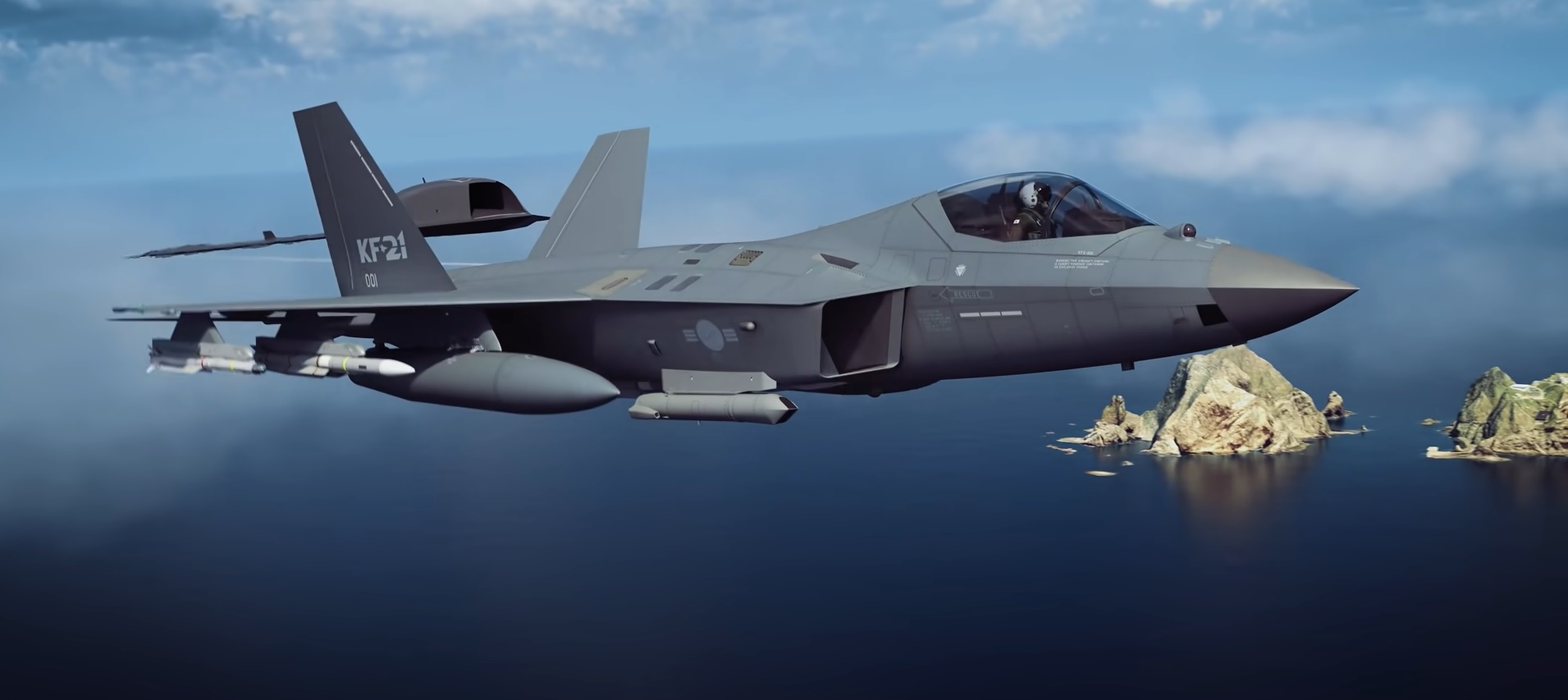South Korea successfully completed the first armament tests on two prototypes of its indigenously developed KF-21 fighter jet on March 28, the country’s arms procurement agency said.
The two prototypes were subjected to two different tests over the waters off South Korea’s southern coast after they took off from the Republic of Korea Air Force’s (ROKAF’s) 3rd Flying Training Wing in Sacheon, which is 300 kilometers south of the country’s capital, Seoul.
Currently, there are four KF-21 prototypes undergoing flight tests under a plan to utilize a total of six for the overall testing scheme set to run 2,000 tests by February 2026. The second and third KF-21 prototypes were used for the tests.
So far, the second prototype has been employed to evaluate the plane’s structural load capacity, while the third prototype is equipped with technologies needed to test the fighter’s speed and loadable weight.
The test on the second prototype involved checking whether an air-to-air mid-range Meteor test missile could be separated from the jet without any problem.
South Korea KF-21 Boramae advanced multirole fighter jet held its first armament test.
KF-21 Prototype No. 2 performed an armament separation test with MBDA Meteor air-to-air missile (without launch), and No. 3 conducted firing from its 20mm autocannon.https://t.co/rygCNG9SNV pic.twitter.com/lr2ktGXwjw
— Status-6 (@Archer83Able) March 28, 2023
While the test on the other prototype involved firing around 100 rounds from a machine gun mounted on the third prototype.
The Defense Acquisition Program Administration (DAPA), South Korea’s arms procurement agency, said the tests examined possible changes to the aircraft’s structure, engine, and aerodynamic features during the weapons’ operation to ensure operational stability and safety.
DAPA said that with the latest tests, the KF-21 has taken “another step” to become a “complete fighter jet” to protect the country’s airspace.
The 8.8 trillion won ($6.9 billion) KF-21 project, which began in 2015, is intended to produce a 4.5-generation supersonic fighter jet that can replace South Korea’s outdated F-4 and F-5 fighters fleet.
The KF-21 will enter the mass-production stage in 2026, and the ROKAF plans to acquire 120 KF-21 fighters by 2032.
Overall, the KF-21 fighter is expected to increase South Korea’s offensive and defensive capabilities in the air. Considering the poor condition of North Korea’s aging air force jets, the KF-21 could easily surpass them.
In particular, the Meteor beyond-visual-range air-to-air missile (BVRAAM) would enable the KF-21 to engage hostile targets beyond 100 kilometers.
The Meteor missile is developed MBD and has the ability to engage highly maneuverable targets. It first entered service on the Swedish Air Force’s JAS 39 Gripens in April 2016. They are also used on Rafale, and Eurofighter Typhoons The Meteor is also intended to equip British and Italian F-35 Lightning IIs aircraft.
In the future, the ROKAF will possess a mix of F-35s for strike operations and KF-21s for air defense, which experts believe would better use the F-35’s superior stealth capabilities and the ability to penetrate the enemy’s air defense radars.
“This concept makes good use of the F-35, which is optimized for attacking ground targets, whereas the KF-21 has been optimized for air-to-air missions,” Abraham Ait, wrote in The Diplomat in 2020.
According to Ait, as production runs of KF-21 increase, it could even replace South Korea’s fourth-generation F-16s and F-15Ks.
The KF-21 is South Korea’s first indigenously produced supersonic fighter jet, demonstrating the country’s ability to produce combat aircraft independently.
So far, only the United States, Russia, China, Japan, France, Sweden, and an alliance of four European nations—the United Kingdom, Germany, Italy, and Spain—are known to have produced and flown advanced supersonic jet fighters.
Furthermore, experts believe the KF-21 also has significant export potential, which, if true, would add the 4.5 generation fighter jet to the list of weapon systems and platforms being exported by the South Korean defense industry that is not only at par with the Western-made one but also relatively cheaper.
For instance, speculations are rife among military observers that amid growing defense cooperation between South Korea and Poland, the latter could emerge as the first European customer of the KF-21 aircraft, especially after buying 48 FA-50 light attack aircraft from South Korea.
The state-owned Polish Armament Group (PGZ) had already indicated this possibility when Polish media asked about its interest in the South Korean jet.
“It is possible that in the future that… an industrial cooperation in the area of development and production of the KF-21 Boramae, where the natural partner for KAI Ltd. would be, among others, Military Aviation Plant No. 2 in Bydgoszcz, the leader of aviation trade in Poland, that already has experience in maintenance and restoration of F-16s or C-130 Hercules,” PGZ told Defense 24 in February.
Apart from that, Thailand, the Philippines, and possibly even Iraq could be considered potential customers for the KF-21, as these countries have also acquired South Korea’s FA-50 light-attack fighter.
Copyright ©2021. The EurAsian Times. All rights reserved